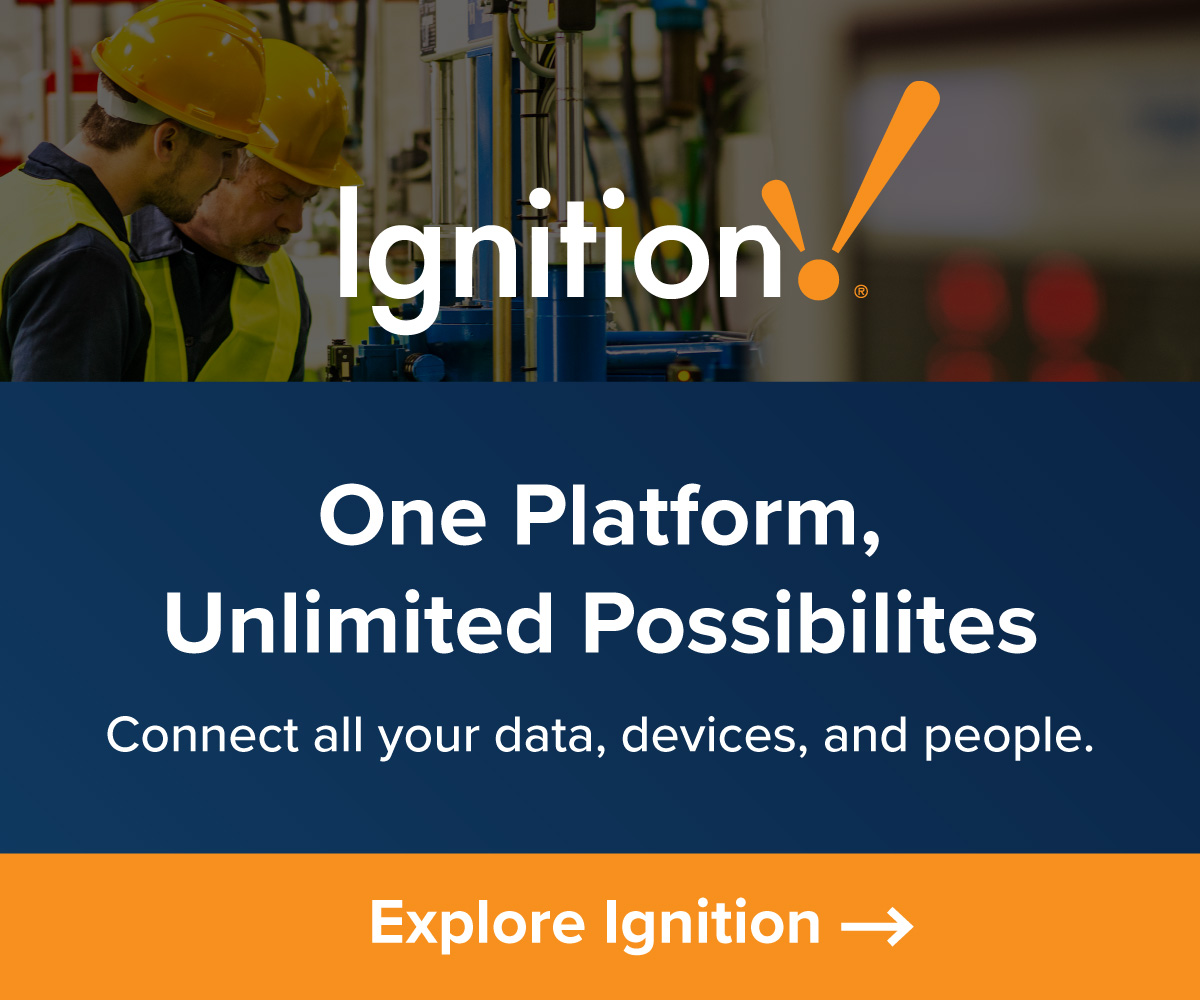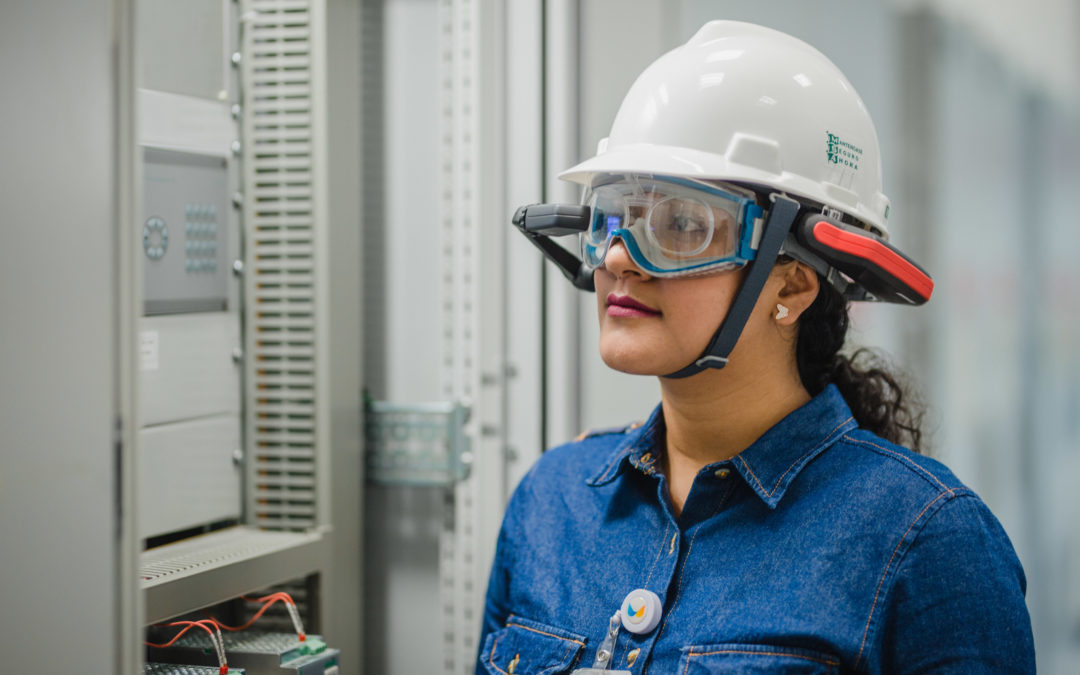
by Gary Mintchell | Sep 3, 2019 | Operator Interface, Safety, Wireless, Workforce
I was working with controls, instrumentation, computers, software when I traded it in for media work first with Control Engineering and then with Automation World. Through a lot of those media years, Honeywell was one of the Big Four or Five in process control and systems. Over the past 6-10 years, those big companies have diverged into differing specialities. It’s been interesting to observe that part of the industrial market.
Honeywell began leveraging expertise of its various divisions into wireless, mobile, and wearables. Much of the emphasis has been safety with a spillover effect into productivity.
Wearables comprise a growing market category with much promise. I’ve had the opportunity to try on a number of different products. These increasingly solve real world problems with ever reducing interference in the real work of the person.
In this latest release, Honeywell announced that Braskem Idesa has adopted a hands-free, wearable connected technology solution at its plant in Veracruz, Mexico. Honeywell’s Intelligent Wearables will allow Braskem Idesa to improve productivity and compliance with process procedures, capture the expertise of experienced workers and provide critical insights and information effectively to trainees and support workers in the field.
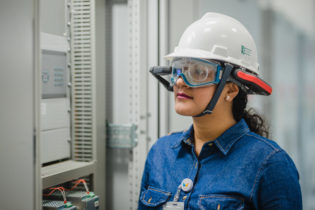
Honeywell is delivering a complete outcome-based solution that tracks specific key performance indicators and integrates hardware, software and services, and a full Wi-Fi infrastructure to support use of the solution across the plant. The wearable technology will also accelerate training and ensure safety for field operators at the Braskem Idesa facility.
“With this solution, Braskem Idesa is embracing the digital transformation that will enable us to retain our leadership in the petrochemicals industry,” said Roberto Velasco Gutiérrez, industrial director, Braskem Idesa. “Capturing all the relevant expertise and data within the organization and getting it to workers wherever and whenever needed, will help get trainees safely into the field faster and ensure that every worker operates to Braskem Idesa’s best standards.”
A comprehensive range of applications from Honeywell will boost the speed, safety and reliability of field workers thanks to the following services:
- Expert on Call: Provides field workers with live, real-time access to experts in the central control room or elsewhere for troubleshooting, support and advice
- Video support: Enables users to view videos demonstrating key tasks
- Paperless rounds: Provides step-by-step instructions for common and complex tasks
“Braskem Idesa has not only taken an important step toward Industry 4.0 but has now also replaced paper-based and manual operations with a sophisticated solution that’s both digital and wireless,” said Vincent Higgins, director of technology and innovation, Honeywell Connected Enterprise, Industrial. “Wearable, voice-controlled computer headsets and software eliminate the need for clipboards, pens, and flashlights. Our offering will help Braskem Idesa capture expertise and document critical tasks to ensure operational compliance.”
Honeywell’s solution for field worker competency and productivity enables Braskem Idesa to tie its plant performance directly to the performance of its workers, critical to the success of any industrial enterprise. By connecting field workers with remote advice, Honeywell Intelligent Wearables also reduce the need for site visits from experts, empower workers to continue learning, become their best and effectively share their knowledge with peers.
by Gary Mintchell | Jul 17, 2018 | Automation, Process Control, Software
Did Honeywell Process Solutions (HPS) short-circuit the Open Process Automation work? Inquiring minds wonder. Once again, some news and analysis of a conference that I couldn’t attend—three of these the same week in June.
HPS and ExxonMobil sent this release. Subsequently, I talked with some sources at competitor companies who broached the question to me—did this news short-circuit the ExxonMobil-led effort for a new process control solution? An interesting caveat is that there is more than one group within ExxonMobil—and they don’t necessarily agree.
From the first release:
The Open Process Automation group was initiated by ExxonMobil who was trying to find a better (less expensive) upgrade path for its control systems that had fallen behind that of its competitors. The oil & gas supermajor still has in operation a significant number of older systems installed as far back as the 1980s—systems that have served the company well for more than 30 years, but as older electronic components have been replaced by more modern alternatives, spare-parts shortages and looming obsolescence put ExxonMobil and other owner operators in a difficult place.
When facing obsolescence, rip-and-replace is clearly the option of last resort—incurring high costs, protracted downtime and the loss of all the intellectual property invested in developing a system’s displays, databases, control strategies and third-party interfaces, according to David Patin, distinguished engineering associate – control systems, ExxonMobil Research & Engineering.
The company’s installed base of Honeywell TDC 3000 systems, in particular, looked to be facing a critical shortage of spare parts in the year 2025, Patin explained. “So in 2011 we met with Honeywell regarding the future of TDC 3000,” Patin began, addressing a plenary session of the Honeywell Users Group Americas 2018 conference this week in San Antonio.
Challenge issued
Unwilling to settle for rip-and-replace, “We challenged Honeywell to develop and prove a method to migrate TDC forward,” Patin said. The two companies established a joint task team to investigate the problem.
ExxonMobil’s wish list of deliverables included avoiding wholesale system replacement (especially the I/O); preserving the company’s intellectual property investment; allowing for on-process migration of system components (meaning without shutting down the process); enabling new capabilities not currently possible with TDC; and unifying TDC with Honeywell’s current state-of-the-art Experion platform.
This last item encapsulated a desire for a solution that would “be usable by a younger workforce, yet stand the test of time,” Patin said. “I picture a third-grader who’s also a future TDC engineer,” he said. “They just don’t know it yet.”
Also implicit in ExxonMobil’s requirements were continued “rock solid” reliability and security, Patin added.
Solution identified
Since the technical obstacles to bringing TDC forward hinged on hardware obsolescence, notably controller microprocessors and communications chips that would no longer be available, the team settled on an emulation approach that would effectively abstract TDC system functionality from the specifics of the older hardware.
And in February 2018, seven years after that first meeting of the minds—and two years ahead of schedule—Honeywell answered ExxonMobil’s challenge with the release of Experion LCN R501.1. The Experion LCN, or ELCN, effectively emulates the TDC system as software. “It’s 100% binary compatible and interoperable with the old system,” Patin explained. “Current TDC code runs unmodified in this virtual environment, greatly reducing the technical risks. Intellectual property such as application code, databases and displays are preserved.”
In the end, the Experion Station, Server, ACE and APP nodes can take the shape of Windows-based “physical” applications or virtual machines. Application Modules, Network Gateway and Network Interface Module functionality is redeployed on Universal Embedded Appliances or as virtual appliances. Only the Enhanced PLC Gateway cannot be readily virtualized because the emulation of serial network connectivity is not well behaved, Patin explained. “This means you can build an almost 100% virtualized or 100% physical system—or somewhere in between.”
With the new solution, LCN and UCN messages are now encapsulated in standard Internet Protocol. “All the old networks now exist as logical constructs on Fault Tolerant Ethernet,” Patin said. “We’re no longer locked into proprietary networks.”
And to address the challenge of on-process migration, Honeywell has also introduced several bridge devices that effectively facilitate the virtualization of TDC system node functionality—without the need to interrupt the process under control.
Benefits achieved
Virtualization of the TDC environment has come with some added benefits, including the ability to use Honeywell’s cloud-based Open Virtual Engineering Platform to engineer TDC solutions; lower cost, smaller footprint training simulators; peer-to-peer integration of virtualized HPM controller nodes with current-generation C300/ACE nodes; support for OneWireless (ISA 100 and WirelessHART) connectivity; and integration with ControlEdge and Unit
Operations Controllers.
“It’ll be a game-changer,” said Patin. “We don’t know all that’s possible as yet.”
Other benefits include a drastic reduction—or elimination—of spare parts, as well as reductions in cabinet space requirements. “We’ve gone from two nodes to six in a single cabinet,” Patin said. “We’ve not fully realized unification with Experion, but that process has begun.”
Overall, Patin gave high marks to the Honeywell team for its response to ExxonMobil’s needs. “The challenge was met, and expectations exceeded,” he said. “The need to replace an entire system is eliminated, future component issues are virtually eliminated (pun intended), intellectual property is preserved and on
process migration is supported.
“ELCN technology essentially resets the odometer on your TDC 3000 investment,” Patin added. “It’s the best example of Honeywell’s commitment to continuous evolution that I’ve ever seen. And if it were a final exam, I’d give Honeywell an A on this one.”
<End of release>
Safety Manager
HPS also announced Safety Manager SC, the next generation of its flagship Safety Manager platform. Its modular, scalable design enables it to function as a single platform for all enterprise safety applications, allowing customers – who are often using four or five different safety systems – to consolidate and reduce their training and engineering costs, and spare parts inventories.
Safety Manager SC incorporates a new Series C-based controller and Honeywell technologies such as LEAP, Universal Safety IO, offline simulation and Experion integration, which collectively simplify safety system engineering, development and testing.
“Our customers increasingly want integrated safety and control solutions and the simplicity of partnering with one supplier for all their needs,” said Tim LeFevre, global customer marketing manager for safety systems, HPS. “We deliver exactly that by combining unrivaled expertise in distributed control systems (DCS) and safety systems with deep integration know-how. Honeywell is one of the few vendors that can support the full safety lifecycle.”
HUG
The ability of Honeywell Connected Plant’s offerings to deliver higher levels of safety, reliability, efficiency and profitability will continue to be the primary discussion point at the 43rdHoneywell Users Group (HUG) Americas symposium. More than 1,300 delegates from across the oil and gas, chemical, pulp and paper, and metals and mining sectors are attending the event, which features numerous displays of the newest technologies along with dozens of Honeywell- and customer-led sessions and technical discussions.
Throughout the conference, Honeywell will showcase how turning data into actionable insight requires more than just upgrading technology; it requires a system for capturing, retaining and sharing knowledge that allows both the plant and its workers to perform at their best every day.
“Digital transformation has to be about more than just moving data into the cloud,” said John Rudolph, president of Honeywell Process Solutions (HPS). “It ultimately has to be about the outcomes, including driving increased productivity and savings for our customers while allowing them to increase knowledge capture, knowledge sharing and knowledge retention among their employees.”
Rudolph was named president of HPS on May 31, 2018, succeeding Vimal Kapur, who was named president and CEO of Honeywell Building Technologies. Rudolph led the Projects and Automation Solutions, and Lifecycle Solutions and Services businesses for HPS over the past six years, driving significant growth. Rudolph also has held leadership roles with TAS Energy, General Electric and Ingersoll Rand.
Here is a revealing comment from the press release about HPS’s strategy and direction—something we’ve all been wondering about. “HUG attendees will be able to see and experience the Company’s ongoing transformation into a software-industrial provider.”
Announcements in brief:
- Thermal IQ – Enables maintenance engineers and plant managers to more effectively monitor and manage their thermal process equipment, minimizing unplanned downtime and maximizing uptime.
- Uniformance Cloud Historian – This software-as-a-service cloud hosting solution for enterprise-wide data capture, visualization and analysis helps customers improve asset availability, optimize processes and increase plant uptime.
- Asset Performance Management – Integrates asset and process data for actionable insights to improve asset performance and plant profitability.
- Immersive Competency – This cloud-based simulation offering uses a combination of augmented reality (AR) and virtual reality (VR) to train plant personnel on critical industrial work activities, empowering them to directly improve plant performance, uptime, reliability and safety.
- Personal Gas Safety – This solution integrates with Honeywell’s leading plant control system to protect workers and speed emergency response in case of hazardous leaks or worker injury.
- Intelligent Wearables – This hands-free, wearable technology allows industrial workers to more safely, reliably and efficiently accomplish their tasks in the plant or the field. It uses a head-mounted visual display that responds to voice and brings live data, documents, work procedures, as well as health and safety information into view and can connect field workers with remote experts in real time.
- Experion Batch – Combines Experion distributed control, batch automation, and new visualization technology for improved efficiency, quality and throughput.
- Measurement IQ for Gas – Provides measurement under control by transforming metering operations with 24/7 real-time condition-based monitoring.
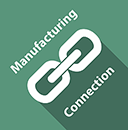
by Gary Mintchell | Mar 1, 2018 | Automation, Operations Management
Honeywell released three announcements while I am still recapping the ARC Forum. There are one or two more to go. Thèse regarded maintenance management, simulation, and safety under the umbrella of Connected Plant.
The first is a new offering as part of Honeywell Connected Plant that allows customers to more effectively manage the maintenance and operations of their industrial equipment. The new Honeywell Connected Plant Asset Performance Insight connects the customers’ assets and equipment to the cloud, and applies analytical models from Honeywell and its partners, so that customers can avoid unplanned downtime and unnecessary maintenance.
“In today’s competitive business climate, in which asset capacity is often sold out, equipment performance is key to increased profitability,” said Richard Shaw, general manager, Honeywell Connected Plant. “With operational and maintenance-induced equipment failures accounting for most of the unplanned downtime, industrial companies are looking to digital transformation and IIoT to make sense out of huge amounts of data. Honeywell Connected Plant and our new Asset Performance Insight will help our customers operate more strategically and effectively.”
Honeywell designed the Asset Performance Insight solution to be rapidly deployed to customers through pre-configured templates. These templates are based on the company’s deep industry experience and real-world customer challenges enhanced with advanced analytics. The offering can also be configured and tailored to customers’ specific needs, making it extremely flexible.
The second is a cloud-based simulation tool that uses a combination of augmented reality (AR) and virtual reality (VR) to train plant personnel on critical industrial work activities. With as much as 50 percent of industrial plant personnel due to retire within the next five years, the Honeywell Connected Plant Skills Insight Immersive Competency is designed to bring new industrial workers up to speed quickly by enhancing training and delivering it in new and contemporary ways.
Honeywell’s advanced training solution combines mixed reality with data analytics and Honeywell’s 25 years of experience in worker competency management to create an interactive environment for on-the-job training. It uses Microsoft’s HoloLens, the world’s first and only self-contained holographic computer, and Windows Mixed Reality headsets to simulate various scenarios for Honeywell’s C300 controller – such as primary failure and switchovers, cable and power supply failure – that train and test personnel on their skills.
“Megatrends such as the aging workforce are putting increased pressure on industrial companies and their training programs,” said Youssef Mestari, program director, Honeywell Connected Plant. “There is a need for more creative and effective training delivered through contemporary methods such as Immersive Competency, ultimately empowering industrial workers to directly improve plant performance, uptime, reliability and safety.”
Simulating specific job activities through virtual environments, which are accessed through the cloud, Honeywell’s solution offers a natural way to interact and communicate with peers or a trainer. Similar to a flight simulator, trainees can safely experience the impacts of their decisions. This approach improves skill retention versus traditional training methods by up to 100 percent and reduces the length of technical training by up to 66 percent. Additionally, the employees’ training progress is tracked as part of a formal competency management system.
And wrapping up is a new solution for real-time safety monitoring of workers in plant and remote operations. Honeywell Connected Plant Skills Insight Personal Gas Safety helps to protect lives and enable faster response in case of hazardous leaks or worker injury.
The solution’s wearable gas detectors monitor gas, radiation and dust, and are tightly integrated with Honeywell’s distributed control system, Experion® Process Knowledge System (PKS). In case of harmful exposures, man-down or panic alarms of workers in the field, accurate, automated alarms now alert control room operators in real time. In addition, safety teams can take advantage of powerful tools embedded in Experion PKS to provide detailed trending, reporting and data analysis of the gas detectors to further ensure safe operations.
“Monitoring worker safety and ensuring proper response to emergencies are top priorities for industrial producers,” said Adrian Fielding, marketing director, Integrated Protective Solutions for Honeywell Process Solutions (HPS). “Personal Gas Safety gives plant operators eyes and ears in the field to improve their situational awareness, helping avoid potentially life-threatening conditions while also providing workers with the assurance that help will be on the way quickly if they need it.”
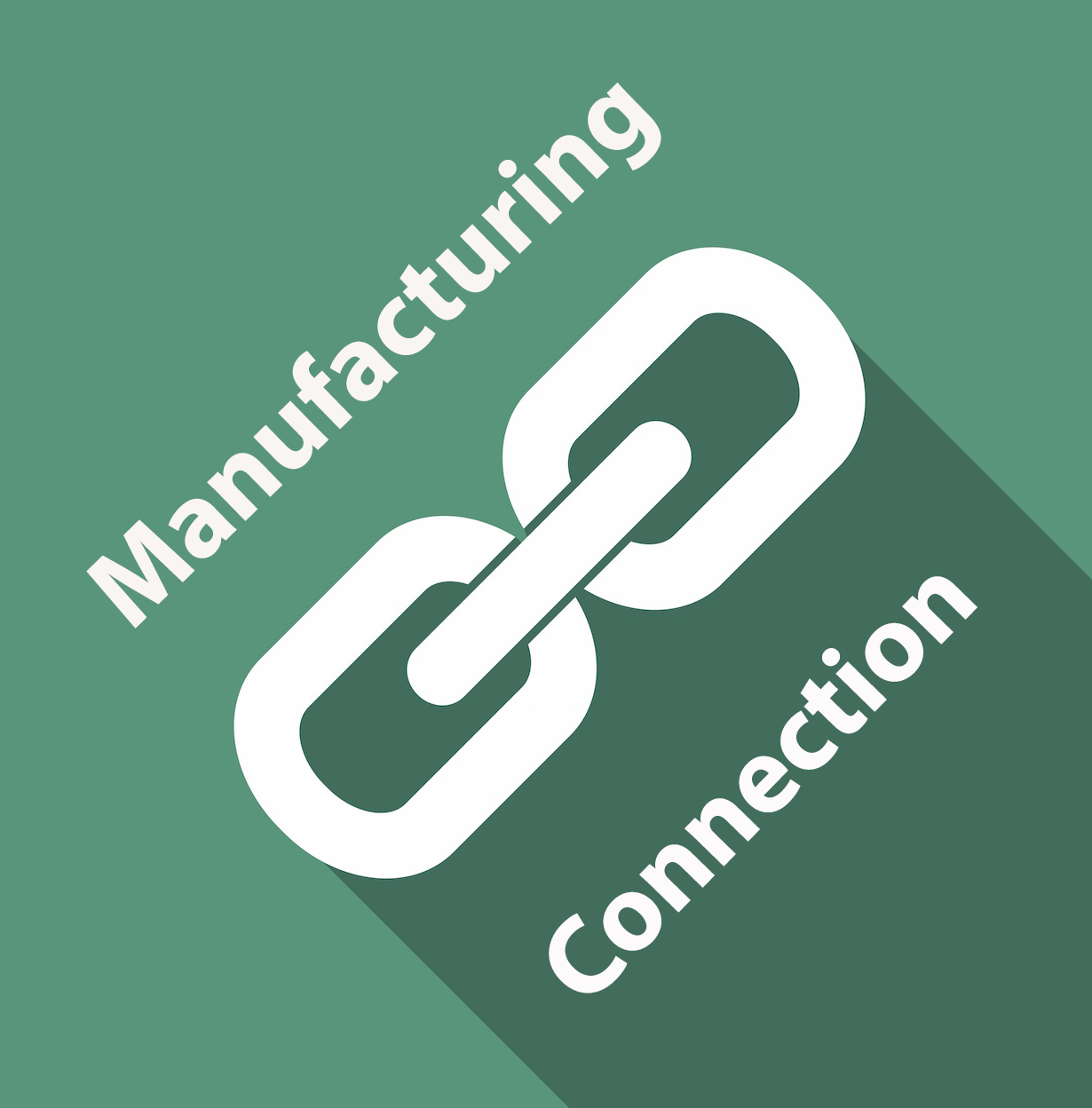
by Gary Mintchell | Jan 18, 2018 | News
Acquisitions are a big reason explaining growth and innovation in big companies. Not that long ago Emerson acquired partner Mynah Technologies. Today I see that it acquired ProSys. These are both good acquisitions. Emerson has a better than average success with acquisitions. ProSys is a good fit. Congratulations.
Emerson announced it has acquired ProSys Inc., a global supplier of software and services that increase production and safety for the chemical, oil and gas, pulp and paper, and refining industries. By building intuitive processes for plant operators, these solutions make everything from everyday operations to responding during abnormal situations easier.
“Adding ProSys’ differentiated technologies and expertise allows us to help our customers improve plant performance, safety and profitability by optimizing their human and automation resources,” said Mike Train, executive president, Emerson Automation Solutions. “With ProSys, we can provide innovative control and operator performance capabilities to make control room operators far more effective.”
ProSys’ portfolio includes solutions that help operators manage alarms critical to plant production and safety, and efficiently handle changing plant states. In addition, ProSys provides modern, high performance and intuitive graphics for better operator communications.
ProSys complements Emerson’s May 2017 acquisition of MYNAH Technologies, which provides dynamic simulation and operator training software. Together, these technologies embed expertise to help operators navigate plant systems safely and efficiently, and prepare customers to accommodate the changing state and age of the industrial workforce.
“Our specialization in software and services that increase operator performance builds on Emerson’s market leadership in automation control systems,” said Dustin Beebe, president and CEO at ProSys. “By working together as one, we can provide even more operational and financial value to customers.”
Beebe will join Emerson Automation Solutions as vice president, control and operator performance.
The ProSys software portfolio supports Emerson’s Operational Certainty program designed to help industrial companies achieve Top Quartile performance in areas of safety, reliability, and production.
Terms of the acquisition were not disclosed.

by Gary Mintchell | Jul 23, 2015 | Automation, Internet of Things, Operations Management
 Tim Sowell, Schneider Electric (Wonderware) vp and fellow, has been writing a weekly blog that I report on for a while now. His Operations Management Systems Evolution blog is always thoughtful and informative.
Tim Sowell, Schneider Electric (Wonderware) vp and fellow, has been writing a weekly blog that I report on for a while now. His Operations Management Systems Evolution blog is always thoughtful and informative.
Recently, I have discovered another Schneider Electric blog, this one by someone whom I do not know (I think)–Gregory Conary.
Each take a look at the Industrial Internet of Things in these posts.
Conary’s recent post discussed the “business opportunities we are seeing emerge from this megatrend.”
He cites information compiled by LNS Research, in its eBook Smart Connected Operations: Capturing the Business Value of the Industrial IoT. 47 per cent of respondents to its Manufacturing Operations Management (MOM) online survey indicated that they did not expect to invest in IoT technologies in the “foreseeable future”. A further 19 per cent indicated that they did not expect to invest in IoT technologies in the next 12 months.
Conary states, “Frankly I’m not surprised. IIoT seems to bring with it the hype of something that will take a long time to adopt. In some cases I think this can be true. And while we are unclear on what time frame is meant by the term ‘foreseeable future’ referenced above, I believe there are business opportunities that can be capitalized on now and in the medium term. IIoT is more prevalent than we imagine. There are examples and business practices that we often don’t even recognize as being enabled by IIoT – things like increasing industrial performance and augmenting operators are two of the opportunities which can make a difference to your business now.”
Increased industrial performance
“Using data to improve industrial performance by connecting things to each other – this is happening now. How is it happening? Through wireless technologies, low cost sensors and using advanced analytics. In practice, this is a decision support system for complex manufacturing operations.”
I agree with Conary. We’ve had the foundation and platform for the Industrial Internet of Things for a long time. It just continues becoming more robust. As better data analytics algorithms are developed and better ways to communicate and display information are devised, then usefulness to manufacturing operators, maintenance technicians, engineers, and managers will increase dramatically.
Tim Sowell riffed off an article in Wired. “As the Internet of Things (IoT) continues its run as one of the most popular technology buzzwords of the year, the discussion has turned from what it is, to how to drive value from it, to the tactical: how to make it work.
We need to improve the speed and accuracy of big data analysis in order for IoT to live up to its promise. If we don’t, the consequences could be disastrous and could range from the annoying – like home appliances that don’t work together as advertised – to the life-threatening – pacemakers malfunctioning or hundred car pileups.”
Sowell adds this analysis, “This follows on from my discussion 2 weeks ago around the need to avoid just gathering data, vs gaining the proportional amount of knowledge and wisdom, which brings in a term you hear a lot ‘machine learning’.”
From Wired, “The realization of IoT depends on being able to gain the insights hidden in the vast and growing seas of data available. Since current approaches don’t scale to IoT volumes, the future realization of IoT’s promise is dependent on machine learning to find the patterns, correlations and anomalies that have the potential of enabling improvements in almost every facet of our daily lives.”
Sowell concludes, “In the industrial world this more applicable than nearly all industries, and in many cases we are already applying “machine levels” at different levels. A key part in the shift from ‘Information’ to ‘knowledge’ is having the tools to drill into historians based on events and to discover learnings and patterns. Once validated and discovered these are turned into ‘self-monitoring’ conditions to understand the current state of the device, and predict / recognize conditions well before they happen. Providing the ‘insight’ to make awareness and decisions where the machines/ devices are telling you where the opportunities are. But a key part of machine learning is that this knowledge in not a once off step, it is a continuous evolution leveraging the gathering history data and developing increased amounts of knowledge.”
Final thought
Both Conary and Sowell point directly to the new reality and to new challenges. We can now gather much more data than we can make sense of. As soon as we have those tools, we will provide better tools to operations and maintenance to improve plant performance.






